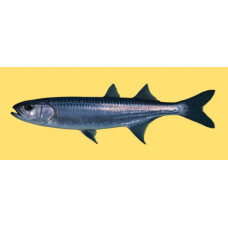Latin name
Atherinomorus lacunosus
Other name
Broad-banded hardyhead, broad-banded silverside, Capricorn hardyhead, pitted hardyhead, robust hardyhead, robust silverside, slender hardyhead and wide-banded hardyhead silverside.
Identification
The Hardyhead silverside is characterised by a very low and broad lateral protrusion of the premaxilla, with the upper edge of the anterior bone of the mandible, on which the teeth are located, being almost flat distally and lacking a distinct tubercle at the posterior end. The mouth has small teeth on the palate which do not form a prominent protrusion. The anus is usually posterior but close to the posterior tip of the pelvic fin. The number of lower gill stamens is 18-24 and the number of mid-lateral scales is 40-44.
Features of fish fins
The dorsal fin has 5-8 spines and 9-10 soft rays, while the anal fin has 1 spine, 12-17 soft rays and 43-44 vertebrae.
Fish colouring
The body of the Hardyhead silverside is translucent, blue-green in colour, with the silvery parts of the abdomen and head often iridescent. There is a silvery band running down the middle of the body, wider than one row of scales, which often merges with the silvery belly at the front of the body. The gill covers and iris are silvery. The dorsal scales usually have fine chromatophores along the edges. Fins are colourless or dark, the pectoral fins often with a blackish spot.
Distribution
Widespread in the Indo-Pacific region (from the east coast of Africa to Tonga and southern Japan and south to the north coast of Australia). Entered the Mediterranean through the Suez Canal.
Habitat
They are marine pelagic fish.
Size
Hardyhead silversides can grow up to 25 cm in length, but are more common in the 10-12 cm range.
Behavior
They congregate in large flocks near the coast during the day, and are inactive during the day. After sunset they disperse, staying about 2-4m apart. In the early morning they gather again in dense flocks and move closer to the shore.
Food and feeding habits
At night they feed on zooplankton: fish eggs, crustaceans, amphipods, foraminifera, ostracods, shrimp larvae. The size of the prey does not usually exceed 0.5 mm. Sometimes the diet includes small fish (herring, mackerel).
Reproduction
In New Caledonia, this species reaches sexual maturity just before the age of one and spawns from late August to December. Fecundity is relatively low and this, combined with the long spawning season, suggests that this species has a spawning strategy in which each individual female spawns several times. Their lifespan is short and they usually die after spawning, although some individuals survive into their second year of life. However, the Seychelles had two spawning seasons, April-June and September-December, corresponding to periods of warming water between monsoons, while the Marshall Islands spawned all year round. In South Africa, spawning occurs near river mouths and lasts from October to January. The eggs are covered with thin fibres that are used to attach the eggs to the substrate or other underwater surfaces.
Fishing
It is an object of fishing. It is sold fresh, salted and dried.
Relationship with a person
Harmless.
| Classification | |
| Phylum | Chordata |
| Class | Actinopterygii |
| Squad | Atheriniformes |
| Family | Atherinidae |
| Genus | Atherinomorus |
| Species | A. lacunosus |
| Features | |
| Conservation status | Least Concern |
| Habitat | Pelagic |
| Life span, years | No information |
| Maximum body weight, kg | No information |
| Maximum length, cm | 25 |
| Sailing speed, m/s | No information |
| Threat to people | Edible |
| Way of eating | Predator |
Hardyhead silverside
Tags: hardyhead silverside


